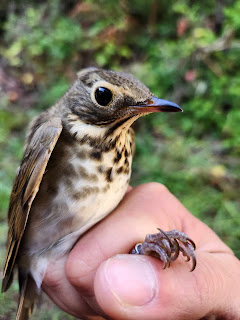Each time you come out to our field sites, you will notice changes in what birds are present week after week during RPBO's fall migration monitoring.
 |
| Golden-crowned Kinglet (above) and Ruby-crowned Kinglet (below) (photos: Mike Motek) |
This week, the fields continue to be chock full of Lincoln's Sparrows, and the Savannah Sparrows have arrived in numbers. We caught our first Golden-crowned Sparrows and Ruby-crowned Kinglets in the mist nets as they became increasingly present on site. Flocks of warblers have shifted to being predominantly Orange-crowned and Yellow, with good numbers of Townsend's present, and Hermit Thrushes now can be heard in the morning alongside the Swainson's Thrushes. Just as the passerine action quiets down in the morning, the Turkey Vultures kettle, and are joined by other migrating raptors including Broad-winged Hawk on good days. An erratic swift flock might zip by. Over the ocean, flocks of geese and ducks migrate by.
 |
| Lincoln's Sparrow (photo: Emma Radziul) |
 |
| Savannah Sparrow (photo: Emma Radziul) |
At Rocky Point, Orange-crowned Warbler (31) and Yellow Warbler (29) were the most banded birds of the week, followed by Lincoln's Sparrow (27) and Savannah Sparrow (24).
At Pedder Bay, the most banded birds were Swainson's Thrush (21) and Hermit Thrush (20). Lincoln's Sparrow (20) and Fox Sparrow (19) were the next most banded birds.
 |
| Pics of Yellow Warbler (photos: Emma Radziul) |
On September 8th, to the surprise and delight of long-term volunteers Julie and Sebastian, they extracted a Lark Sparrow from net 1, which is a net just off the ocean and bordering the open central field. This bulky sparrow showed first-winter plumage with a brown-ish, less distinct harlequin facial pattern and a smooth, white, unpatterned chest with dark central spot. Even though just grown a few months ago, this bird's juvenile flight feathers and coverts were seen to have sun bleaching and wear. A few of its long, patterned tail feathers had been asymmetrically lost and were in the process of regrowing. This is the first Lark Sparrow banded for RPBO. The northernmost portion of the Lark Sparrow's breeding range is south interior British Columbia, and it is a rare migrant through Vancouver Island. Only one other Lark Sparrow has been seen at our field site (in 2023) in 30 years of monitoring.
 |
| Lark Sparrow pics (photos: Emma Radziul) |
On September 10th, bander Evan Lewis had the pleasure of banding a presumed Golden-crowned x White-throated Sparrow hybrid. This individual's unusually streaky flanks (which are usually smooth and patternless in pure Golden-crowned Sparrows), along with its broken eyeline extending slightly behind the eye, patterning on the hind-crown, and location and extent of yellow on the crown and face point to the parentage of the suspected hybrid. Only 25 observations of Golden-crowned x White-throated hybridization have ever been reported to ebird.

 |
| Hybrid Sparrow Pics (photos: Evan Lewis) |
On September 13th, two Sharp-shinned Hawks were mist-netted. Look at the size difference between the hatch-year male vs. female (the female being larger). This had been a much-wanted species for bander-in-training Mark Byrne, who was lucky enough to extract and band one.
 |
| Sharp-shinned Hawk pics (photos: David Bell) |
Rocky Point's weekly total of 258 new birds banded was below the week 8 average of 304 (partially owing to a 1 day closure to our access to RP). Rocky Point's season total to date is 2456 which is above the average year-to-date of 1794 and stands second place all-time for this date. Pedder Bay's weekly total of 184 new birds caught is well below the week 8 average of 293 birds. Pedder Bay's season total to date is 1417, which is the second lowest all-time by this date. The average PB year-to-date is 1725.
On September 12, we captured an Olive-backed subspecies of Swainson's Thrush. The majority of our migratory Swainson's Thrushes are from the Russet-backed group (ustulatus group), which has a reddish tinge to it's back, rump and tail with the tail being redder than the back, and smaller, less distinct breast spots. The Olive-backed group (swainsoni group) has a solid olive back, rump, and tail without contrast or reddish tones and heavy, well-defined black spotting on the throat and chest. The russet-backed Swainson's Thrushes breed coastally, from Southeast Alaska to Northern California west of the Cascades, and winter primarily in West Mexico and Central America, while the olive-backed Swainson's Thrushes breed more centrally and winter further sound in Northwest and central South America.
 |
| Pics of Olive-backed Swainson's Thrush (photos: David Bell) |
On September 12th, an Upland Sandpiper was seen flying over Pedder Bay, and heard and recorded giving a liquid "qui-di-dit" call. This was the first record of this species for Pedder. Bander David Bell is quite familiar with this species having worked with grassland breeding birds in the Canadian Prairies for the past several spring/summer seasons, and this bird did not elude the keen eyes of visitors Taylor and Adam, who laid eyes on this uniquely shaped shorebird as it flew over.
First of the season observations at Rocky Point this week include: Osprey (Sept 10), White-throated Sparrow (Sept 13) and Cackling Goose (Sept 13). First of the season observations at Pedder Bay also include Northern Harrier (Sept 10).
We hope everyone had a lovely September week. Stay tuned -- or better yet, get out to the field! -- to find out what will show up next at RPBO's two migration monitoring sites.
 |
| Three photos of Common Yellowthroat (photos: Evan Lewis) |
 |
| MacGillvary's Warbler (photo: Emma Radziul) |
 |
| Chestnut-backed Chickadee (photo: Emma Radziul) |
 |
| Hutton's Vireo (photo: Emma Radziul) |
 |
| Click on photo to expand |




























No comments:
Post a Comment